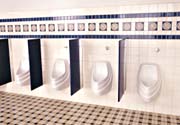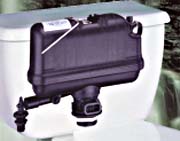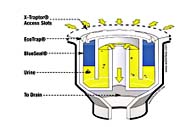

When it comes to conserving water, the United States suffers from multiple personality disorder. There are those who carefully limit every drop of consumption, while others splash away as though there is an endless supply. Some users disconnect lawn sprinklers, limit showers and recycle grey water. Others water landscaping when it's raining and drain their water heaters with every bath.
This contradiction was illustrated perfectly in two consecutive days in our nation's top national newspapers. On Dec. 18, 2002, the Wall Street Journal ran a front-page article ("A Tiger in the Tank: High-Pressure Toilets Shake up Bathrooms") which focused negatively--and selfishly--on the "inconvenience" of noisy press-assisted low-consumption toilets. On Dec. 19, USA Today offered a better take ("West's dry areas get creative with water use") by profiling home and land owners' resourceful water-conserving techniques in the drought-plagued West.
For those who have championed water conservation technologies and have been treated like Chicken Little, the latest water-use trends and products bring some redemption. The sky really is falling, or in this case, water supplies really are disappearing. Fortunately, as rivers, lakes and aquifers empty, meaningful advancements in conservation products have brought renewed interest in saving water. Many of these new products compete well with conventional water delivery products in performance, aesthetics and price. No more cheap washers in showerheads and bricks in water closets.
Over the course of last year, all but a few states endured some type of drought impact according to the National Drought Mitigation Center (www.drought.unl.edu). As this article was being written in January, more than two-thirds of U.S. states were labeled as containing current drought areas, areas recovering from drought or drought watch areas.

Why Save Water?
Until recently, specifiers and building managers have had little incentive to conserve water, except in a few drought areas. Nationally, water conservation got a huge boost with the passage of the national Energy Policy Act of 1992, which mandated the introduction of 1.6-gpf toilets and reduced flow rates for showerheads. Aside from those regulations, water conservation has been largely ignored.But wait. A host of new challenges and opportunities have pushed conserving water to the forefront of construction and remodeling design.
- Water rates are skyrocketing as treatment facilities struggle to keep up with burgeoning demand.
- More communities are unable to supply demand and now mandate strict water use limits for new construction. Some even offer generous rebates for installing conservation products.
- Home and building owners now endure frequent water restriction alerts, complete with fines for violations, much the way "rolling brownouts" have impacted energy use.
- Well water systems are becoming unsafe and unpredictable, increasing the burden on municipalities.
- The U.S. Green Building Council (USGBC) offers points for water conservation as part of its Leadership in Energy & Environmental Design (LEED) initiative, encouraging specifiers to "go green" when selecting water systems.
- Newer water conserving products have largely eliminated the performance complaints associated with their first- and second-generation predecessors. Some products eliminate water use entirely.

Water Conserving Product Performance Has Evolved
While the Dec. 18WSJarticle presented a negative view of pressure-assisted toilets, it was correct in identifying noise as a user complaint. First-generation editions could generate a noisy flush. But new-generation pressure-assist devices and new bowl designs substantially reduce flushing decibels. Early 1.6-gpf gravity flush toilets frequently clogged, but newer designs perform better and must pass a demanding drainline carry test. Similarly, improvements in showerhead design and plumbing now produce more consistent and forceful sprays. Sensor-controlled urinals, faucets and flush valves are more dependable. Waterless urinals allow for some really large savings for commercial facilities. Never have specifiers enjoyed so many choices."Market demand is building for additional water saving. Specifiers are ready to jump in wholeheartedly," says Paul DeBoo, marketing manager for Sloan Flushmate (Franklin Park, IL), which sells pressure-assist devices for low-consumption toilets. "Their only concerns have been limited selection and getting a competitive price. While there are extra manufacturing costs to produce water savings, they are easily cost-justified over the life of the product."
DeBoo points to a current study of the Lansdale, PA, Homewood Suites. Additional water savings provided by Flushmate's new four-liter pressure-assist units allowed the developer to expand the hotel's capacity from 146 to 170 rooms while using the same amount of water.
DeBoo also said USGBC's LEED program is convincing growing numbers of engineers and architects to select high-performance water conservation products. "Based on activity levels in inquiries, interest among specifiers has picked up geometrically. They are primarily interested in getting fixtures that reduce consumption up to 20% or more so they can qualify for LEED Water Efficiency Credits 3.1 or 3.2, each which contribute a full point to a building's overall score." (For a more thorough explanation on qualifying for LEED Water Efficiency Credits, visit the feature archives at www.pmengineer.com to read an article authored by DeBoo titled "The Greening of Plumbing.")

Gravity Flush Toilets Rev Up
Because some first generation 1.6-gpf toilets clogged easily or left "skid marks," they developed reputations as poor performers. Users sometimes said they flushed multiple times, supposedly reversing water savings. But studies have shown that even with occasional double flushes, overall, 1.6-gpf gravity toilets have produced tremendous savings nationwide. A three-year study by the American Water Works Association Research Foundation concluded that consumers with 1.6-gpf toilets flushed 5.04 times per day versus 4.92 times per day for older 3.5-gpf models, representing a daily savings of 9.18 gallons or 53% per toilet. Toilet manufacturers have responded to these performance complaints with a broad array of options:
Geberit Manufacturing (Michigan City, IN) offers the Tessera 1.6-gpf toilet, featuring an in-wall flush valve and insulated, polyethylene storage tank, resulting in a quieter flush and saving up to 9 inches of legroom. Visit www.us.geberit.com.
Gerber Plumbing Fixtures (Lincolnwood, IL) offers both pressure-assisted (see below) and gravity flush toilets. Gerber recently redesigned its Aqua Saver toilet with an expanded well and jet to provide faster siphon starting, resulting in larger volumes of bulk being removed. Other features include a flush valve designed for maximum head pressure, a volume-rated rigid flapper, and a performance-designed trapway. Visit www.gerberonline.com.
Kohler (Kohler, WI) offers the Ingenium flushing system on its 1.6-gpf toilets. Kohler claims the jet-siphon system's performance is comparable with previous 3.5-gpf models and features a whirlpool-like vortex to resist plugging and fully glazed trapways. Visit www.kohler.com.
Briggs Plumbing Products (Charleston, SC) offers the reengineered Vacuity WhisperVac flushing system in its 1.6-gpf toilets. The system uses a new chinaware bowl design and a stronger vacuum-assist flush (licensed from Fluidmaster) to provide a quieter, more efficient flush. The system features larger traps, deeper seals and an oversized water surface thus minimizing blockages and minimizing noise. Visit www.briggsplumbing.com.
Caroma USA (Toronto) offers the Caravelle 1.6-gpf dual-flush toilet. The model features a 4-inch trap and a wash-down flush system to reduce blockage. Visit www.caromausa.com.
Eljer Plumingware (Dallas) offers the Berkeley 1.6-gpf gravity and Aqua-Saver (see below) pressure-assist toilets. The Berkeley is a one-piece unit with a concealed trap. Visit www.eljer.com.
American Standard (Piscataway, NJ) offers the Cadet 1.6-gpf toilet. American Standard toilets use its AquaForce flushing system to provide a powerful, quiet, siphonic swirling action to create a vacuum that pulls waste through the trapway. Other features include a large water surface area and fully glazed trapway resulting in performance "even better than many older 3.5-gpf models." Visit www.americanstandard.com.
Crane Plumbing (Evanston, IL) offers the Atlas 1.6-gpf toilet. Visit www.craneplumbing.com.
WP Industries (Norwalk, CA) offers the Western Aris and Clinton 1.6-gpf toilets. Visit www.wpindustries.com.

Pressure-Assisted Toilets Get Quieter, Stronger
Even before federal mandates required 1.6-gpf toilets, inventors like Bruce Martin were tinkering with devices that use pressure to compensate for reduced water consumption. Martin, whose Water Conservation and Technology Corp. (now Intertech Corp.) developed the two leading pressure-assist devices, focused on improving waste removal in order to overcome the concerns of engineers and building owners worried about clogging. The result is two outstanding products that assure 1.6-gpf or less of flushing water is enough to pass stringent drainline carry tests.Sloan Flushmate is introducing its fourth-generation Flushmate IV flushometer tank system pressure-assist system, using just 1.4-gpf (4 liters). This unit is available now in some St. Thomas Creations toilets and will be in more toilet manufacturers' units shortly. Visit www.flushmate.com.
Geberit liked the PF2 pressure-assist tank so much, it bought the manufacturing rights from MASCO (Taylor, MI). The PF2 By Geberit pressure-assist unit can be found in both the company's wall-hung and floor-mounted toilets. The PF2 units operate off of 1/2-inch supply lines with a minimum of 35 psi. The PF2 unit also is available in other manufacturers' brands.

Commercial Flush Valves Become Automated
As a result of LEED and other water conservation programs, increasing numbers of specifiers are asking how today's flush valves help save water, according to Susan Kennedy, Sloan Valve director of marketing. Although Sloan has produced water control products since 1906 and electronic controls since the late 1980s, its sales of sensor-operated products is now growing at its fastest pace. "Automated valves avoid double and triple flushes, and that translates into tremendous water savings," Kennedy says.Specifiers' growing interest in water conservation is noted by manufacturers. "There isn't a new product design we consider that doesn't conserve water," Kennedy added. "The more we save, the better."
Sloan Valve (Franklin, IL) offers a wide range Royal flushometer valves for commercial applications. Most valves are available using Sloan's Optima electronics technology, which senses use and regulates flushing. Visit www.sloanvalve.com.

Geberit offers a flush valve that uses a turbine flow meter, which allows flushing in 1/10-gallon increments. This allows urinal flushing using just 7/10 of a gallon instead of the normal 1 gallon, resulting in water savings of 30%, according to the company. Visit www.us.geberit.com.
Zurn Plumbing Products Group (Erie, PA) offers a variety of flush valves for commercial applications. Visit www.zurn.com.
Coyne & Delany (Charlottesville, VA) offers a range of sensor-, push-button and manually operated Delany flush valves for commercial applications, including the Impulse battery-powered sensor valve. Visit www.coynedelany.com.

Newer Urinals Use No Water
Falcon Waterfree Technologies offers several urinal models that use no water and requires no inlet piping. The urinal uses a recyclable ABS cartridge containing a biodegradable filtering liquid, which forms a barrier between open air and urine, sealing odors within the cartridge. Urine then passes through the cartridge and into the drain. Cartridges are replaced every 7,000 uses. According to the company, each cartridge can help save 9,000 gallons of water. Visitwww.falconwaterfree.com.Waterless Co., LLC, offers several models of its No-Flush urinals that operate without water or flush valves for new or retrofit applications. The urinals use a vertical EcoTrap cartridge and X-Traptor access slats, which allow urine to enter at the top and then filter through a Blue Seal odor-controlling liquid, before exiting through existing 2-inch waste lines. Each urinal can save 45,000 gallons of water per year, according to the company. Visit www.waterless.com.